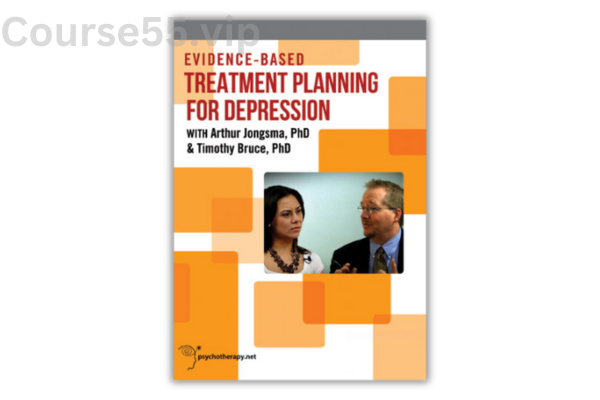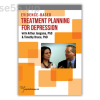Evidence-Based Treatment Planning for Depression with Timothy Bruce & Arthur Jongsma
$49.00 Original price was: $49.00.$7.70Current price is: $7.70.
Evidence-based treatment planning for depression: A Comprehensive Review – Digital Download!

Evidence-Based Treatment Planning for Depression with Timothy Bruce & Arthur Jongsma
Overview

A Thorough Guide to Designing Evidence-Based Treatment Plans for Depression
Introduction
In today’s world, the prevalence of mental health struggles is steadily rising, making it more crucial than ever to discover and implement effective treatment strategies. The Evidence-Based Treatment Planning for Depression series, led by Drs. Timothy Bruce and Arthur Jongsma, offers a comprehensive and practical approach for mental health professionals working with individuals experiencing depression. This resource not only emphasizes research-backed methodologies but also connects theory with practice, making it a valuable tool for therapists seeking to enhance their skills in treating depressive disorders. With its integration of empirical support and real-world application, this series is essential for professionals committed to refining their clinical practices.
The series is characterized by its focus on the foundational aspects of treatment, including diagnosis, goal-setting, and intervention selection. Each video session is accompanied by practical demonstrations, ensuring that practitioners can translate research into effective clinical application. Through these evidence-based methods, therapists are equipped with the tools to form deeper, more meaningful connections with their clients, which is crucial for successful therapeutic outcomes. What sets this series apart is its emphasis on practical application, providing clinicians with concrete examples that enhance learning and promote active engagement. Additionally, the companion workbook offers a helpful summary of key topics and encourages interactive learning, making the material accessible and easy to integrate into clinical settings.
Critical Elements in Developing Evidence-Based Treatment Plans
Key Elements of Effective Treatment Planning
Creating effective treatment plans requires a structured approach that includes several key components. Drs. Bruce and Jongsma detail these essential steps, ensuring that practitioners fully understand each critical element of treatment planning. The primary components include:
-
Diagnosis: Identifying the type and severity of depression using the DSM criteria is fundamental to understanding the client’s condition.
-
Treatment Goal Definition: Setting clear, measurable goals is vital. These goals must align with the client’s individual experiences and objectives.
-
Selecting the Right Interventions: This step involves choosing empirically supported treatments (ESTs) such as cognitive restructuring, behavioral activation, and problem-solving, ensuring that the treatment is both effective and personalized.
By considering these steps in detail, clinicians can design treatment plans that not only adhere to research findings but are also tailored to the unique needs of each client.
Exploring Empirically Supported Treatments
The series offers a detailed examination of various empirically supported treatments (ESTs), each proven to be effective for managing depression. The key strategies include:
-
Cognitive Restructuring: This approach helps clients identify and challenge negative thought patterns, leading to a more optimistic outlook and healthier mental processes.
-
Behavioral Activation: By encouraging clients to re-engage with activities they once found fulfilling, this technique aims to combat feelings of inertia and improve mood.
-
Problem-Solving Therapy: This strategy equips clients with the tools to address life challenges proactively, building confidence and resilience in the face of obstacles.
With the integration of clinical demonstrations, professionals gain a clear understanding of how to apply these techniques, enhancing their ability to implement them effectively in their own practice.
Preventing Relapse and Offering Continued Support
Effective Relapse Prevention Strategies
One crucial aspect of treatment is preparing clients for potential setbacks and fostering resilience. Drs. Bruce and Jongsma emphasize the importance of relapse prevention strategies, which include:
-
Identifying Triggers: Helping clients recognize personal triggers that might lead to a recurrence of depressive symptoms empowers them to respond appropriately.
-
Developing Coping Skills: Equipping clients with tools to manage stress and challenges reduces the risk of future depressive episodes.
-
Building Support Systems: Encouraging clients to establish strong, supportive relationships ensures they have emotional resources to maintain progress and well-being.
By proactively addressing relapse, clinicians can support clients in maintaining their gains and navigating challenges with resilience, which is essential for long-term recovery.
Real-Life Applications Through Case Vignettes
What makes this series particularly valuable are the case vignettes that showcase real-life applications of the strategies discussed. These examples allow clinicians to see how theoretical concepts are translated into tangible, clinical outcomes. For instance:
-
Case Example 1: A client struggling with major depressive disorder learns to apply cognitive restructuring techniques. Through this approach, the client is able to challenge negative beliefs, fostering a more positive and balanced outlook on life.
-
Case Example 2: A client with chronic anxiety and depression engages in behavioral activation. By reconnecting with previously enjoyable activities, the client experiences a rediscovery of purpose, which helps reduce feelings of hopelessness.
These case examples help practitioners see the direct impact of evidence-based methods on client outcomes, enhancing their confidence in utilizing these strategies.
The Companion Workbook: A Tool for Deepening Understanding
The companion workbook is an essential resource that supports clinicians’ understanding of the material. It serves as a comprehensive guide, summarizing the key points from each session and offering additional resources for further exploration. Key features of the workbook include:
-
Full Transcripts of Case Vignettes: These transcripts allow clinicians to revisit important discussions, reinforcing understanding and facilitating further reflection.
-
Discussion Questions: These questions promote collaborative learning and stimulate deeper thinking, helping practitioners integrate new knowledge with their existing skills.
-
Self-Assessment Tools: These tests allow clinicians to evaluate their grasp of the content, identifying areas for growth and ensuring continued professional development.
The workbook is designed to foster an interactive and reflective learning environment, ensuring that the information is internalized and applied in clinical settings.
Fostering Collaboration and Continuous Improvement
Mental health treatment planning is often a collaborative process, and the workbook supports this by encouraging group discussions and shared learning experiences. By engaging in dialogue with peers, practitioners can gain diverse perspectives, enhancing their overall expertise and refining their clinical techniques. This collaborative approach fosters a culture of continuous learning and improvement within mental health teams, which is essential for providing the best possible care.
Bridging the Gap Between Research and Clinical Practice
One of the most significant contributions of the Evidence-Based Treatment Planning for Depression series is its ability to bridge the gap between academic research and clinical practice. Although there is abundant research supporting the efficacy of various therapeutic methods, translating this knowledge into day-to-day clinical application can be challenging. Drs. Bruce and Jongsma offer practical tools that make it easier for practitioners to implement evidence-based methods with confidence. This series transforms research into actionable strategies, enabling clinicians to integrate these findings into their therapeutic practices effectively.
The Impact on Practitioners
By engaging with the material provided in this series, mental health professionals will not only learn new techniques but also gain the confidence to integrate research into their daily practices. As clinicians develop a deeper understanding of evidence-based methods, they become more skilled in delivering care that promotes better outcomes for clients. The cyclical nature of learning and practice ensures that each new insight enhances clinical competence, ultimately improving the quality of care and advancing the field of mental health treatment.
Conclusion: An Indispensable Resource for Mental Health Professionals
In conclusion, the Evidence-Based Treatment Planning for Depression series by Drs. Timothy Bruce and Arthur Jongsma is an invaluable resource for mental health practitioners. With its structured approach, insightful demonstrations, and focus on evidence-based practices, the series provides a comprehensive framework that enhances both clinician knowledge and client outcomes. As the mental health field continues to evolve, such resources become essential tools for improving treatment practices, fostering professional growth, and providing clients with the support they need to manage depression effectively.
Frequently Asked Questions:
Business Model Innovation: We operate a group buying strategy, allowing participants to share costs and access popular courses at reduced prices. This model benefits individuals with limited financial resources, despite concerns from content creators about distribution methods.
Legal Considerations: The legality of our operations involves complex issues. Although we don’t have explicit permission from course creators to resell their content, there are no specific resale restrictions stated at the time of purchase. This ambiguity creates an opportunity for us to provide affordable educational resources.
Quality Control: We ensure that all course materials purchased are identical to those offered directly by the creators. However, it’s important to understand that we are not official providers. As such, our offerings do not include:
– Live coaching calls or sessions with the course author.
– Access to exclusive author-controlled groups or portals.
– Membership in private forums.
– Direct email support from the author or their team.
We aim to reduce the cost barrier in education by offering these courses independently, without the premium services available through official channels. We appreciate your understanding of our unique approach.
Be the first to review “Evidence-Based Treatment Planning for Depression with Timothy Bruce & Arthur Jongsma” Cancel reply
You must be logged in to post a review.

















Reviews
There are no reviews yet.